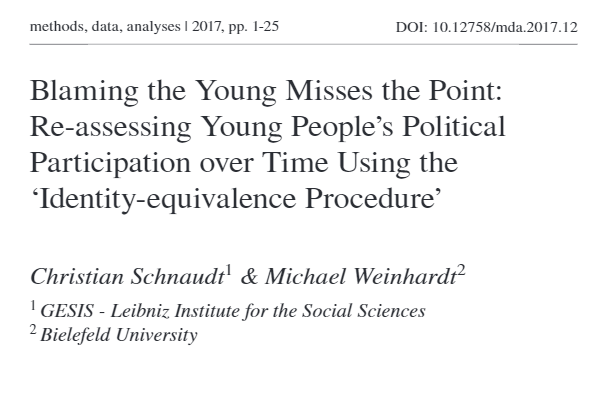
The study Blaming the Young Misses the Point: Re-assessing Young People’s Political Participation over Time Using the ‘Identity-equivalence Procedure by Ch. Schnaudt from Leibniz Institute for the Social Sciences and M. Weinhardt from Bielefeld University offers a re-assessment of young people’s political participation by investigating the structure and levels of political participation across young, adult and old people in Germany over the period 2002-2014.
Negative portrayals (of growing political apathy of young people) are often countered by the observation that young people, while possibly being alienated from traditional electoral or formal politics, do engage in non-electoral or informal modes of political participation that reach beyond the realm of institutionalized politics (cf. Vissers & Stolle 2014, 937; Cammaerts et al 2014, 657; Sloam 2014, 676). In comparison with adults, then, young people’s political participation seems to be less formal, less institutionalized, and less hierarchical, and they appear to prefer more individualized, lifestyle-oriented modes of participation such as signing petitions, protesting, or political consumerism (cf. Sloam 2013, 837; Stolle, Hooghe & Micheletti 2005, 250). If these assertions are correct, it is clear that a comparison of political participation between young and adult people does not only have to consider the level of participation, but also the respective modes of participation being used by young and adult people, respectively.
...
Analyses of youth participation need to consider young people as a specific group with their own particular circumstances and concerns” (2003, 46). In this connection, Quintelier has methods, data, analyses | 2017, pp. 1-25 6 argued that “young people operate with a very narrow conception of politics that is restricted to formal politics only” (2007, 177; see also O’Toole et al., 2003, 52). If we consider this limited and narrow conception of politics to inform their conception and understanding of political participation as well, young people’s political participation may be less facetted and based on fewer modes of participation than that of adult people.
...
On average, participation levels are lowest for the oldest age group and highest for the group of adults. The group of young people occupies the medium position. What is more, the figures indicate an increase in the average participation rates for certain items over time across all age groups (e.g., working for an organization, signing a petition, boycotting products). Other forms of participation, such as working for a political party or wearing a badge, remain at rather stable levels across time and age groups.
Schau an, die Jugend ist gar nicht politikverdrossen...